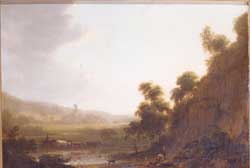 |
 |
 |
 |
 |
 |
 |
|
Mills, fisheries, turbaries, ponds, mineral rights, rights of passage (13/15) Mills, fisheries, turbaries, ponds, mineral
rights, rights of passage The Cistercian Order prohibited its abbeys from receiving revenues from mills, since this undermined the ideal that monks should live by the sweat of their own brows and not that of others. Communities could, however, have mills for their own use, but were not to profit from these by collecting ‘multure’, the tax demanded from those who were obliged to grind their corn at the mill. This prohibition was not always observed and it was sometimes difficult to uphold if the benefactor granted land with a mill included. Indeed, Kirkstall acquired a mill at Mickley in the twelfth century from Robert le Peitevin. The Bramhope family gave the community the village mill at Bramhope, which the monks leased to St Leonard’s Hospital, York, in 1274, for 40s p.a.(27)
Most monastic mills were powered by water and used to grind grain; others were driven by horsepower. There are remains of a mill within Kirkstall’s precinct. (28)
|
